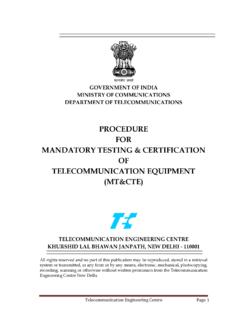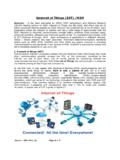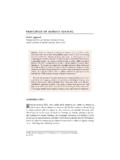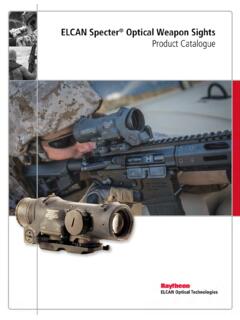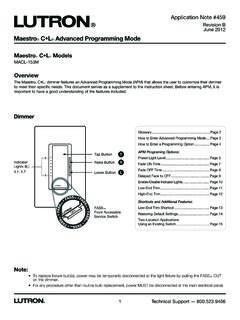Transcription of lifi study paper - approved - Tec
1 study paper on LiFi (Light Fidelity) & its Applications FN Division, TEC Disclaimer: This study paper uses the information as available in public domain or from the web sites of entities claiming to be in the field of Li-Fi technologies. This information has been presented only to support the study on the subject and not to promote any company or its products in any manner. Abstract Li-Fi stands for Light Fidelity. The technology is very new and was proposed by the German physicist Harald Haas in 2011 TED (Technology, Entertainment, Design) Global Talk on Visible Light Communication (VLC). Li-Fi is a wireless optical networking technology that uses light emitting diodes (LEDs) for transmission of data.
2 The term Li-Fi refers to visible light communication (VLC) technology that uses light as medium to deliver high-speed communication in a manner similar to Wi-Fi and complies with the IEEE standard IEEE The IEEE is a high-speed, bidirectional and fully networked wireless communication technology based standard similar to Wi-Fi s IEEE This paper focuses on Li-Fi, its applications, features and comparison with existing technologies like Wi-Fi etc. Wi-Fi is of major use for general wireless coverage within building, whereas Li-Fi is ideal for high density wireless data coverage in confined area and especially useful for applications in areas where radio interference issues are of concern, so the two technologies can be considered complimentary.
3 Li-Fi provides better bandwidth, efficiency, connectivity and security than Wi-Fi and has already achieved high speeds larger than 1 Gbps under the laboratory conditions. By leveraging the low-cost nature of LEDs and lighting units, there are lots of opportunities to exploit this medium. Li-Fi is the transfer of data through light by taking fibre out of fibre optics and sending data through LED light bulb (shown in Fig 1). Fig 1: LED light Li-Fi Bulb (Source: ) Content Page No. Introduction ..1 Architecture of Li-Fi system ..2 Working of Li-Fi.
4 4 Comparison between Li-Fi and Wi-Fi and other Radio Communication Technologies ..7 Applications of Li-Fi ..10 Future scope ..14 Conclusion ..15 References Abbreviations 1 1. Introduction In the era of overcrowded (data communication) world, Li-Fi is a new way of wireless communication that uses LED lights to transmit data wirelessly. Transmission of data is one of the most important day to day activities in the fast growing world. The current wireless networks that connect us to the Internet are very slow when multiple devices are connected. Also with the increase in the number of devices which access the Internet, the availability of fixed bandwidth makes it much more difficult to enjoy high data transfer rates and to connect a secure network.
5 Radio waves are just a small part of the electromagnetic spectrum available for data transfer. Li-Fi has got a much broader spectrum for transmission compared to conventional methods of wireless communications that rely on radio waves. The basic ideology behind this technology is that the data can be transferred through LED light by varying light intensities faster than the human eyes can perceive. This technology uses a part of the electromagnetic spectrum that is still not greatly utilized- The Visible Spectrum, instead of Gigahertz radio waves for data transfer. The idea of Li-Fi was introduced for the first time by a German physicist Harald Hass in the TED (Technology, Entertainment, Design) Global talk on Visible Light Communication (VLC) in July 2011, by referring to it as data through illumination .
6 He used a table lamp with an LED bulb to transmit a video of a blooming flower that was then projected onto a screen. In simple terms, Li-Fi can be thought of as a light-based Wi-Fi instead of radio waves it uses light to transmit data. In place of Wi-Fi modems, Li-Fi would use transceivers fitted with LED lamps that could light a room as well as transmit and receive information. By adding new and unutilized bandwidth of visible light to the currently available radio waves for data transfer, Li-Fi can play a major role in relieving the heavy loads which the current wireless system is facing. Thus it may offer additional frequency band of the order of 400 THz compared to that available in RF communication which is about 300 GHz.
7 Also, as the Li-Fi uses the visible spectrum, it will help alleviate concerns that the electromagnetic waves coming with Wi-Fi could adversely affect our health. By Communication through visible light, Li-Fi technology has the possibility to change how we access the Internet, stream videos, receive emails and much more. Security would not be an issue as data can t be accessed in the absence of light. As a result, it can be used in high security military areas where RF communication is prone to eavesdropping. 2 2. Architecture of Li-Fi system Li-Fi which can be the future of data communication appears to be a fast and cheap optical version of Wi-Fi. Being a Visible Light Communication (VLC), Li-Fi uses visible light of electromagnetic spectrum between 400 THz and 800 THz as optical carrier for data transmission and illumination .
8 It uses fast pulses of light to transmit information in wireless medium. The main components of a basic Li-Fi system may contain the following: a) A high brightness white LED which acts as transmission source. b) A silicon photodiode with good response to visible light as the receiving element. Switching the LEDs on and off can make them generate digital strings with different combination of 1s and 0s. To generate a new data stream, data can be encoded in the light by varying the flickering rate of the LED. In this way, the LEDs work as a sender by modulating the light with the data signal. The LED output appears constant to the human because they are made to flicker at a phenomenal speed (millions of times per second) and it s impossible for human eye to detect this frequency.
9 Communication rate more than 100 Mbps can be achieved by using high speed LEDs with the help of various multiplexing techniques. And this VLC data rate can be further increased to as high as 10 Gbps via parallel data transmission using an array of LED lights with each LED transmitting a different data stream. The Li-Fi transmitter system comprises of four primary subassemblies: Bulb RF Power Amplifier Circuit (PA) Printed Circuit Board (PCB) Enclosure Fig 2: Block Diagram of Li-Fi sub-assemblies. (Source: ) 3 The Printed circuit board (PCB) controls the electrical inputs and outputs of the lamp and houses the microcontroller used to manage different lamp functions.
10 A Radio Frequency (RF) signal is generated by the Power Amplifier and is directed into the electric field of the bulb. As a result of the high concentration of energy in the electric field, the contents of the bulb will get vaporized into a plasma state at the bulb s centre. And this controlled plasma in turn will produce an intense source of light. All of these subassemblies are contained in an aluminium enclosure as shown in Fig. 2 above. Li-Fi Bulb sub-assembly: The bulb sub-assembly is the main part of the Li-Fi emitter. It consists of a sealed bulb embedded in a dielectric material which serves two purposes: one, it acts as a waveguide for the RF energy transmitted by the PA (Power Amplifier) and two, it acts as an electric field concentrator that focuses the energy into the bulb.

